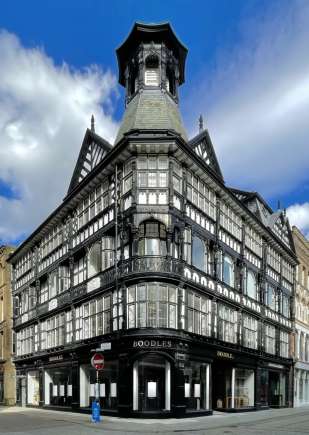Goodall Lamb and Heighway, Nos.15 and 17 King Street, Manchester
NEW PREMISES FOR GOODALL LAMB AND HEIGHWAY KING STREET MANCHESTER - This building has recently been completed for the occupation of Messrs Goodall Lamb and Heighway, cabinet makers and decorators of King-street Manchester, one of the principal business streets of the city, and occupies the site of the old premises in which the business of Messrs Goodall’s firm had been carried on since 1827. The style adopted is in harmony with the nature of the business for which the building was designed, being an adaptation to modern uses of timber-framed architecture of the seventeenth century. The frontages are entirely constructed of European oak, solidly framed and pinned with wooden pegs; the pilasters and other ornamental features being carved in the solid wood. The timber framing is filled in and backed up with brickwork as required by the local authorities. The panels between the framing are faced with cement and painted white. Internally the building consists of one large room on each floor; a sub-basement for packing purposes; basement, and five floors above ground devoted to showroom purposes. A goods lift is provided in the rear of the premises and a passenger lift gives access to all floors. Round this lift is formed the principal staircase, of dark oak, in character with the general design. The interior generally is handsomely treated in fibrous plaster. The ornamental metalwork is by Mr Geo. Wragge. The internal plasterwork and decorations are by Messrs Goodall Lamb and Heighway. The general contract has been carried out by Messrs C Peters & Sons of Rochdale, under the supervision of the architects, Messrs Maxwell and Tuke, of Manchester.
In connection with their new premises, it is interesting to note the steady growth of the present business, which was founded 7i years ago by Mr. Edward Goodall, who retired in 1859, having built up a very considerable business which had involved rebuilding and extension of the premises both in King-street and Police-street. On his retirement Mr. R. M. Esplin entered the firm, and under his able management the business continued to develop, and in 1888 was formed into a limited company, and eventually in 1898 was amalgamated with the old established firm of Heighway and Son, painters and decorators, and the firm of Mr. James Lamb, one of the most eminent cabinetmakers in the North of England, the combined firms assuming the title of Goodall, Lamb, and Heighway, Ltd. The present premises, as previously mentioned, consist of five floors, which are utilised to their utmost capacity ; the top floor is set apart for library and office furniture, the second and third floors to bedroom and drawing-room suites, the first floor to carpets, and the ground floor to massive sideboards, a variety of rich furniture and furnishing fabrics, and the decoration department, for which the firm enjoys a high reputation, while the basement is devoted to grates, mantels, and tiles. The workshops of the firm are in Cobden-street. Lower Broughton, where about 200 hands are employed in the cabinetmaking, carving, upholstering, and polishing rooms, and the manufacture of parquet flooring. A special feature of the business, however. is the striking collection of art furniture made from Nelson's old flag ship, the Foudroyant, which was purchased by Messrs. Goodall, Lamb and Heighway after being wrecked at Blackpool, examples of which we have but recently illustrated.(BN vol 80 p788} The interior of the premises which we illustrate today shows the foot of the main staircase which runs from the top to the bottom of the building, and is an exact copy of the Jacobean staircase at Chetham College, and was arranged by Messrs. Maxwell and Tuke, while the ceiling of the ground floor is an exact reproduction of the ball-room ceiling of Haddon Hall. [Building News 22 November 1901 page 687]
According to a Goodall’s advertisement in the Manchester Guardian, the building was fully complete by 30 April 1901. However, earlier Goodall adverts suggest that the building was occupied, at least in part, for some months before. [Manchester Guardian 30 April 1901 page 1}
Reference Building News 22 November 1901 Page 687
